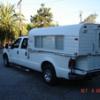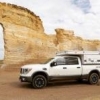Cleaning Fridge Burner on Norcold N300
#1

Posted 24 June 2012 - 06:33 PM
------------------
CLEANING THE REFRIGERATOR BURNER -- Norcold N300
1. Make sure the gas is turned off at the tank.
2. Remove the lower and upper exterior vented covers over the back of the refrigerator by turning the black fasteners 90 degrees.
3. Vacuum away all dust and cob webs in the compartment.
4. Remove the screw holding the sheet metal burner cover and slide the burner cover back toward the back of the vehicle, leaving the wire running through the grommet hole. The burner housing is located on the floor of the fridge compartment toward front of vehicle.
5. Using 20 to 25 psi air, blow out the area behind the burner cover and vacuum any dust residue remaining in the compartment.
6. Using a 5/8" wrench, remove the flare nut on the right hand side (toward the front of the vehicle) of the tee fitting in the gas line.
7. Using a #2 Phillips screw driver, remove the screw that fastens the burner to the burner housing. Gently move the copper pilot fuel line as needed to position the screw driver.
8. After the screw is removed, gently slide the burner out of the housing toward the rear of vehicle (left), making sure that the tip of the burner unit is still aligned vertically when it emerges through the second hole in the housing.
9. Vacuum any dirt or soot from the burner unit and note the nut that is adjacent to the chrome portion of the burner unit. Put a wrench on this nut and a vice or vice grip pliers on the chrome tube. Loosen the chrome tube by unscrewing it counter-clockwise. Once it is loose by turning it a turn or two, remove vice grips or vice and unscrew the tube the rest of the way. (This lessens any deforming of the chrome tube so it will unthread the rest of the way easier.)
10. Using a .22 caliber rifle cleaning brush attached to a section of cleaning rod, run it inside the chrome tube to clean out any soot. Blow out residue with compressed air.
11. Inspect the four slots at the end of the tube, just back from where the tube is crimped flat on the end. Slide heavy card paper (3 X 5 card) through the slots to clean soot from the openings and blow out any residue.
(NOTE: I found the 4 slots in my unit to be quite dirty and non-uniform in width. I took a thin file and made them all the same width. My burner is noticeably audible now, but it idles down when the refrigerator is at temperature and not "calling for refrigeration.")
12. Inspect the nozzle on the end of the brass fitting removed from the chrome tube—it is stainless steel colored. DO NOT attempt to separate the stainless steel from the brass. With a magnifying glass inspect the nozzle hole to see if it appears clean and round. If it appears to have a speck of debris in the hole try to vacuum it out. If unable to remove, or if hole is deformed, nozzle should be replaced.
13. Reinstall nozzle into chrome tube, tighten somewhat firm with a wrench and set aside.
14. In the upper compartment, locate the top of the burner chimney and remove the rectangular chimney cap by twisting and pulling upward.
15. Under the chimney cap is a stainless steel wire from which the spiral baffle hangs. Reaching up with a small hook, position the hook under the wire to get it into the hook. With the wire in the hook, lift the wire about ½ inch out of the chimney. The wire is counter bent so that it is hooked into a hole in the back of the chimney toward the driver's side of the vehicle. The wire must be dropped down slightly and worked out of this hole. When the wire is free from this side hold in the chimney, the wire and spiral baffle can then be lifted out of the chimney, being careful to gently bend the wire back down so it doesn't punch through vent screen in camper or damage refrigerator components.
16. With wire & spiral baffle removed from chimney, cut a piece of contractors line (string) about 8 feet long. Fold line in half to locate mid-point of line and tie a single overhand knot near the mid-point of line and leave the knot loop open about an inch in diameter. Cut a piece about 4" X 6" from an old tee shirt. Insert this cloth lengthwise into the knot hole so it is half way in and tighten the knot hole. About 3 inches of cloth should be extending from each side of the knot. On one end of the line, tie ¼ inch nut.
17. With your chimney cleaning tool you just made, insert the nut into the chimney and lower it down to the bottom. Use a magnetic retrieving wand to snag the nut from the bottom of the burner housing and gently pull the rag down the chimney. Pull down until you can see the rag. Unless you cut your rag too small, the rag will bind if you try to reverse direction. If it is cut about the right size it should fit by the pilot burner unit and you should be able to pull the sting right through. If you notice any significant resistance in trying to get the rag past the pilot burner, you might have cut your rag too large and you would need to remove the Phillips screw that attaches the pilot burner to get the rag out.
Repeat at least two more times resulting in running the rag down the chimney a total of at least three times.
18. Vacuum up the residue in the burner housing from cleaning the chimney and once all residue is vacuumed, blow out the burner housing area with blasts of 100 psi air, making sure that the pilot burner gets a good blast or two.
19. With a clean rag, wipe off the spiral baffle and wire to remove all soot. Install spiral baffle into the chimney and insert hook into the side hole in chimney as it was from the factory install.
20. Twist and push the chimney cap back onto the chimney, making sure the open side of the cap points toward the passenger side of the vehicle.
21. (Reinstall the pilot burner if it had to be removed in step. 17.) Position the main burner so that the screw hole is at the top and toward the driver side of the vehicle and insert the main burner into the housing, keeping the crimped end vertical to pass through the slots. Using a #2 Phillips screw driver with a magnetic tip, install the screw that holds the burner in the housing.
22. Hand tighten the compression fitting nut (right nut) onto the brass tee of the gas line. With a 5/8" wrench on the left nut on the tee (toward rear of vehicle) and a 5/8" wrench on the right nut on the tee, turn the right nut with the wrench until it is tightened properly.
23. Slide the burner housing cover down the wire and position back in place and install the screw into the cover and tighten.
24. At this point, everything should have been reassembled. Double check by visually inspecting the unit to make sure nothing has been omitted.
25. To test the unit, turn the gas back on at the tank and check the valve in the refrigerator compartment to make sure it is on. Light the unit according to the manufacturer's procedure.
26. A clean burner and chimney may require the refrigerator setting to be lowered (made warmer) so that the contents do not freeze. The setting might have been turned up (made colder--wishfully) somewhat to get the unit to cool properly with a dirty burner. If the burner had been quite dirty, the sound level of the burner flame may be more noticeable after cleaning.
#2

Posted 25 June 2012 - 02:16 AM
BTW...Welcome to the forum
and thanks for the comment on the structural fix at AK
looking forward to more
2003 Ford 250 Superduty Crew.... 7.3L PowerStroke diesel 1970 10" NCO Alaskan Firestone airbags pulling a 18' Silver Streak runabout
#3

Posted 24 June 2015 - 08:46 PM
Just found this searching for a way to improve the performance of my 3-way Norcold. I think I will have to give this a chance before I take it out and try rolling it around.
purchased used, 2007 Hawk, fridge, hot water, awning, sitting on 2016 Nissan Titan XD Diesel Pro4X.
Learning the tricks and trying to keep my mod bug in check.
#4

Posted 12 July 2015 - 01:45 PM
keeping the burner area clean....spotlessly clean.....helps in keeping the flue clean as well....every year as the season approaches...vac it out and wipe all surfaces down before firing it up
as in #3, 9, 18.......vac, vac, vac
Edited by Rusty, 12 July 2015 - 01:47 PM.
2003 Ford 250 Superduty Crew.... 7.3L PowerStroke diesel 1970 10" NCO Alaskan Firestone airbags pulling a 18' Silver Streak runabout
0 user(s) are reading this topic
0 members, 0 guests, 0 anonymous users














